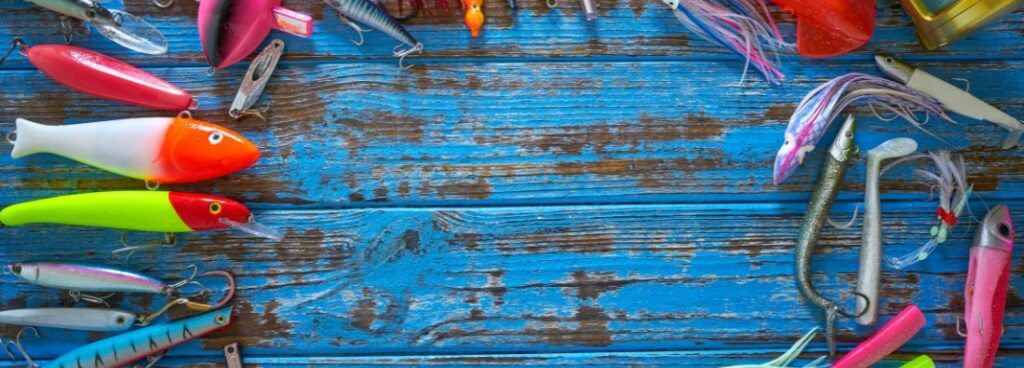Stories Worth Reeling In...
Last Updated on August 9, 2023
Are you a fishing enthusiast wishing to improve your angling skills?
Every angler must decide whether to utilize live bait or artificial bait. While each has its own set of advantages, it is critical to grasp the pros and disadvantages of each before making a selection.
In this piece, I’ll discuss the advantages of using live bait, such as worms, minnows, and crickets, and the simplicity of using artificial lures.
I’ll cover all you need to know when picking between live bait and artificial bait, from recognizing the fish you’re hoping to catch to considering your personal tastes.
So grab your fishing rod, bait your hook, and let’s debate live bait vs. artificial bait for the ideal fishing experience.

Table of Contents
When deciding between live bait and artificial bait, consider the type of fish, location, and your own preference. Live bait can be effective but also perishable, expensive, and hard to handle. Artificial bait can be convenient, and last longer but may not be as effective and can be expensive. Ultimately, it’s all about what works best for you.
One of the most significant advantages of live bait is its natural attraction to fish. Fish are more likely to bite on something that looks, smells, and tastes like what they naturally eat.
This is why live bait is frequently considered the more conventional option for fishers.
Depending on the species of fish you’re attempting to capture, live bait may be more effective in certain fishing conditions.
Live bait, such as worms, minnows, and crickets, attracts catfish, carp, and bass.
While live bait has advantages, it also has disadvantages. The expense is one of the most significant disadvantages.
Buying live bait daily can mount pricey, especially if you’re fishing in an area not recognized for its live bait.
Because it is perishable, live baits are more challenging to handle, store, and transport.
You must keep them cooled and treat them cautiously.
It can also be challenging to move depending on the live bait you’re using.

One of the most significant advantages of artificial bait, often known as lures, is its convenience. Lures are simple to use and adjust.
Some species, like bass and walleye, have a higher tendency to strike artificial baits over live bait. However, panfish and catfish are more likely to take live bait compared to artificial lures.
Let’s dive into the fascinating world of fishing techniques and how they impact the choice between live and artificial bait.
Imagine gliding across serene waters, with your line trailing behind your boat, enticing fish with a moving target. That’s trolling, an effective technique for covering large areas and reaching fish at different depths.
When it comes to trolling, artificial lures often take center stage. Their vibrant colors and realistic movements mimic the appearance of prey, making them irresistible to predatory fish like salmon, trout, and muskies.
Whether it’s a flashy spoon, a diving plug, or a wobbling crankbait, artificial lures excel in this method by maintaining a consistent and enticing presentation.
Jigging is like a seductive dance with your bait. It involves lifting, dropping, and jerking the bait to mimic the movements of injured or struggling prey. This technique is particularly effective in attracting bottom-dwelling fish like walleye, bass, and cod.
Here’s where the choice between live and artificial bait gets interesting. For jigging, live bait shines. Minnows, worms, or leeches suspended on a jig can be irresistible to fish, especially in scenarios where they’re lethargic or finicky.
The natural movement and scent of live bait can trigger strikes that artificial lures might struggle to achieve.
Casting is the quintessential image of fishing, where you aim and cast your bait toward a specific target. This technique is versatile, suitable for both freshwater and saltwater fishing, and can be used from shorelines, docks, or boats.
When casting, the choice between live and artificial bait can depend on the situation. In scenarios where accuracy and precision matter, artificial lures offer control over presentation.
Whether it’s a topwater popper, a swimbait, or a soft plastic worm, these lures allow you to cover a range of depths and water structures, enticing fish hiding in different zones.

When picking between live bait and artificial bait, keep the sort of fish in mind. Distinct fish species have different preferences, so keep this in mind when selecting your bait. For example, if you’re fishing for bass, use a worm as live bait because bass love worms. Similarly, fishing for trout, you should use a small minnow as live bait because trout are known to be drawn to minnows. Artificial lures that mimic little fish, on the other hand, are a fantastic option when fishing for pike.
Another critical element to consider is the fishing location. Different fishing areas may have different types of fish, so choose bait that is known to be effective for that species.
For example, fishing in a lake known for its bass population, you’ll want to use a lure or live bait proven to catch bass.
Weather conditions play a role in the bait choice. In clear conditions, live bait might attract fish, whereas low visibility situations or specific weather patterns can make artificial lures more effective due to their flash and vibrations.
Finally, fishing is a personal experience, so consider your tastes when picking between live bait and artificial bait. Some anglers prefer the conventional method of using live bait, while others prefer the convenience of lures. It all comes down to what works best for you and what you are most comfortable with.
So, anglers, what did we learn today? We’ve examined the benefits and drawbacks of both live and artificial bait and the elements to consider when choosing between the two.
We’ve discussed how live bait has a natural appeal to fish but is more challenging to handle and store, whereas artificial bait is more convenient and has a longer shelf life but may be less successful in some scenarios.
When it comes down to it, the choice between live and artificial bait is a personal one. It’s critical to consider the sort of fish you’re attempting to catch, the fishing area, and your personal tastes.
Whether you’re a traditional angler who favors live bait or a modern angler who prefers lures, the most essential thing is to have fun and enjoy the experience.
So, put up your fishing rod, bait your hook, and let the good times roll. Tight lines!
Hello man, honestly what you posted is very interesting and I love your niche cause I’ve always loved fishing, I also guessed you had a good fishing stick, anyway it depends on the kind of fish you want to get, the live bait helps getting bigger fishes while the other one…Well it’s more efficient for the smaller ones and kinda useless for the big ones, keep it up and be fine
Hey, Edoardo. Thank you for your comment!
Personally, I prefer lures because I like to fish predators like bass and anchovies, and they work great! You are right never caught a big ONE! Max I did was about 2kg or so…
Have to keep fishing, right?!?
Cheers M8